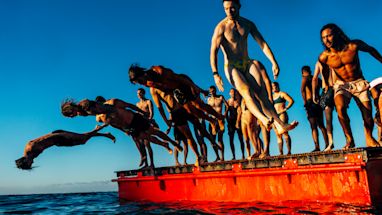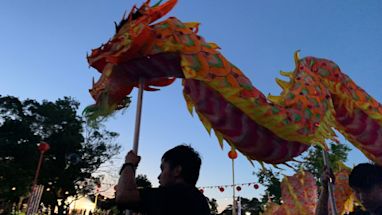Published 4 March 2020
Australian feminist icons illuminate Sydney laneway for International Women’s Day
‘Patchwork of Light’ by Lara Schnitger champions equality for all.
Women in vivid colour
Inspirational women, transformative dates and strong symbols all feature in ten striking lightboxes at the end of Reiby Place.
Patchwork of Light by Lara Schnitger launched for International Women’s Day in March 2020.

Crowd funding to Olympic gold
Sydneysiders Mina Wylie and Fanny Durack were close friends and swimming rivals.
Despite great achievements in the pool they were refused entry to the 1912 Stockholm Olympics due to a rule which forbade women from competing in the presence of men. After a public outcry, the women organised their own fundraising to the Games.
Durack became the first Australian woman to win a gold medal; Wylie the first to win silver.
Here they stand together, their arms and bodies crossed in unity and defiance.

The great businesswoman on your twenty dollar note
Born in England in 1777, Mary Reibey was sentenced to seven years transportation to Sydney at the age of thirteen for stealing a horse.
In 1794 she married, and when her husband died, she took over his numerous trading businesses while caring for their seven children.
Known for her determination and business ethic, Reibey became an astute trader and property investor.
Her rags to riches story is now remembered on the Australian twenty-dollar note and the namesake of Reiby Place, where this artwork is displayed.

A woman needs a man like a fish needs a bicycle
The slogan ‘a woman needs a man like a fish needs a bicycle’ was popularised by American feminist Gloria Steinem in the 1970s.
Not commonly known is the phrase’s Australian origin which Steinem used as inspiration. Irina Dunn, writer, social activist, and filmmaker, coined a similar expression in 1970 when she was a student at the University of Sydney.
Artist Lara Schnitger said ‘I enjoyed the humour and truth of the phase; an absurd notion brought to life [in the artwork] in the image of a disoriented fish pedalling a bicycle.’

From the right to vote to a female Prime Minister
Australia was one of the first countries in the world to give women both the right to vote and the right to stand for Commonwealth Parliament.
In 1884 Henrietta Dugdale formed the first Australian women’s suffrage society. In 1902 most Australian women over the age of 21 were granted the right to vote in federal elections and stand for parliament. In 1962 Aboriginal and Torres Strait Islanders were given the right to vote. In 2010, Julia Gillard became the first woman elected Prime Minister of Australia.

Wyan gi pyalla
In collaboration with Aunty Bronwyn Penrith, Wiradjuri elder and campaigner for equality of Aboriginal people for over 20 years, the artist was introduced to the phrase Wyan gi pyalla – ‘Fight the right fight’.
Based on Sydney Aboriginal language words wyanga (mother) and byalla (speak) these two words combine to embody women’s empowerment.

Bara fish hooks of the Eora Fisherwomen
The ‘Eora’ refers to the Aboriginal people of Sydney. The Eora fisherwomen were the main food providers for their families, giving them status and power in their society.
Eora fishing women made their own tools, including beautiful crescent-shaped bara or fish-hooks made from the turban shell. These bara were sometimes worn like necklaces. Not as decorative objects but as women's working tools, essential for survival.
In this patchwork of history and culture the bara simply bears the word ‘equal’. Feminism means equality for all.

This girl is glowing
The Eora fisherwomen set small fires on a clay pad in their nawi or canoe. The fire was used to cook their catch, to keep them warm and as a source of light.
The artist explains, ‘Fire can be used to scare or to warn. It can symbolise power and illuminate. Let’s pass it on.’

A patchwork of history and culture for all
The shapes and colours in Patchwork of Light draws upon the tradition of quilting bees, when women came together to make huge blankets. The social aspect was often more important than the physical outcome as women sat together sharing their stories, concerns and advice.
This work aims to create that same sense of community. A patchwork of history and culture for everyone.

Iron will
All the women shown in this artwork have it. The women involved in creating this artwork have it. To make a change you need it. This is an ode to what it takes.

Be the walker not the dog
A fun feminist slogan to encourage you to take the lead.



